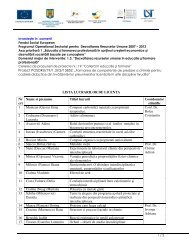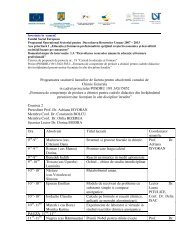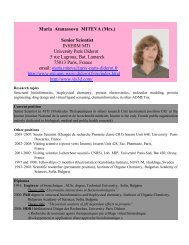rezumatele tezelor de doctorat susÈinute în anii 2009 â 2010
rezumatele tezelor de doctorat susÈinute în anii 2009 â 2010
rezumatele tezelor de doctorat susÈinute în anii 2009 â 2010
- No tags were found...
You also want an ePaper? Increase the reach of your titles
YUMPU automatically turns print PDFs into web optimized ePapers that Google loves.
UNIUNEAEUROPEANĂGUVERNUL ROMÂNIEIMINISTERUL MUNCII, FAMILIEI ŞIPROTECȚIEI SOCIALEAMPOSDRUFondul Social EuropeanPOS DRU2007-2013Instrumente Structurale2007-2013Investeşte în oameni!FONDUL SOCIAL EUROPEANProgramul Operaţional Sectorial pentru Dezvoltarea Resurselor Umane 2007 – 2013OIPOSDRUUNIVERSITATEADE VEST DINTIMIŞOARASummaryThe aim of this study was to investigate the stability of thin liquids films in foams. The thinfilms were studied with the microinterferometric method of Scheludko to obtain the film drainage andthe film thickness, and with thin film pressure balance method to obtain the disjoining pressureisotherms of the films. The surface tension of the aqueous solutions used was measured with theWhilhelmy method and with the pendant drop method. From the surface tension isotherms it wasobtained also the critical micellar concentration and the critical aggregation concentration.To study the film drainage and the critical thickness were used aqueous solutions of thenon-ionic surfactants n-do<strong>de</strong>cyl-β-D-maltosi<strong>de</strong> and n-do<strong>de</strong>cyl-hexa-ethylene-oxi<strong>de</strong>. It was prouvedthat the thin liquids films in foams containing the sugar surfactant n-do<strong>de</strong>cyl-β-D-maltosi<strong>de</strong> have thesame ten<strong>de</strong>ncy of their drainage coefficient and their critical thickness <strong>de</strong>pen<strong>de</strong>nces on the film radiiand on the concentration, as other films containing only classic nonionic surfactants. In the futuresuch surfactants, bio<strong>de</strong>gradable and non-toxic as n-do<strong>de</strong>cyl-β-D-maltosi<strong>de</strong>, could be used in<strong>de</strong>tergents or in cosmetics.In the same time, to study the disjoining pressure isotherms of the films and the isoelectricpoint of the film surface, were used aqueous solutions containing cationic surfactant (tetra<strong>de</strong>cyltrimethyl-ammonium-bromi<strong>de</strong>)and oppositely charged polyelectrolyte (polystyrene sodium sulfonateand polyacrylamido-mehyl-propane sodium sulfonate). The results obtained for the films containingthese mixtures showed that the reduction of the net charge in the foam film leads to strong reductionin their stability. The minimum in stability of films containing surfactants and oppositely chargedpolyelectrolytes occurs around the nominal isoelectric point (IEP). Below the IEP the reduction in netsurface charge is explained by the adsorption of polyelectrolytes at the surface and the formation ofsurface active surfactant/polyelectrolytes complexes. The increase in film stability above the IEPcannot be simply explained by a charge reversal due to an excess of polyelectrolytes. The increase insurface tension and the <strong>de</strong>crease in elasticity imply rather a loss in material. The fact that the stabilityand the surface potential are higher than far below the IEP indicates that the excess ofpolyelectrolytes within the film core contributes to the electrostatic repulsion rather than to ascreening.297POSDRU 21/1.5/G/38347”Parteneriat local pentru ridicarea nivelului şcolilor doctorale şi valorificarea potenţialului uman din cercetare îndomenii prioritare ale etapei posta<strong>de</strong>rare a României la UE”











